MIS712: Strategic E-Business Analysis of Slices Restaurant
VerifiedAdded on 2023/06/13
|11
|1660
|402
Case Study
AI Summary
This case study provides a strategic analysis of Slices Restaurant, focusing on its e-business strategies within the UAE market. It employs a PESTLE analysis to assess the political, economic, social, technological, legal, and environmental factors impacting the business. Porter's Five Forces analysis evaluates the competitive landscape, including the threats of new entrants and substitutes, competitive rivalry, and the bargaining power of suppliers and buyers. Furthermore, the study examines Slices' core competencies through Porter's Generic Strategies model, considering cost leadership, differentiation, and focus strategies. The analysis identifies challenges such as political instability, inflation, health-conscious consumers, and competitive pressures. The study concludes with a strategy recommendation for Slices, emphasizing customer retention through credit extensions, maintaining affordable pricing, focusing on healthy and organic food options, and enhancing food quality to gain a competitive advantage. Desklib provides access to this case study and numerous other solved assignments and past papers for students.
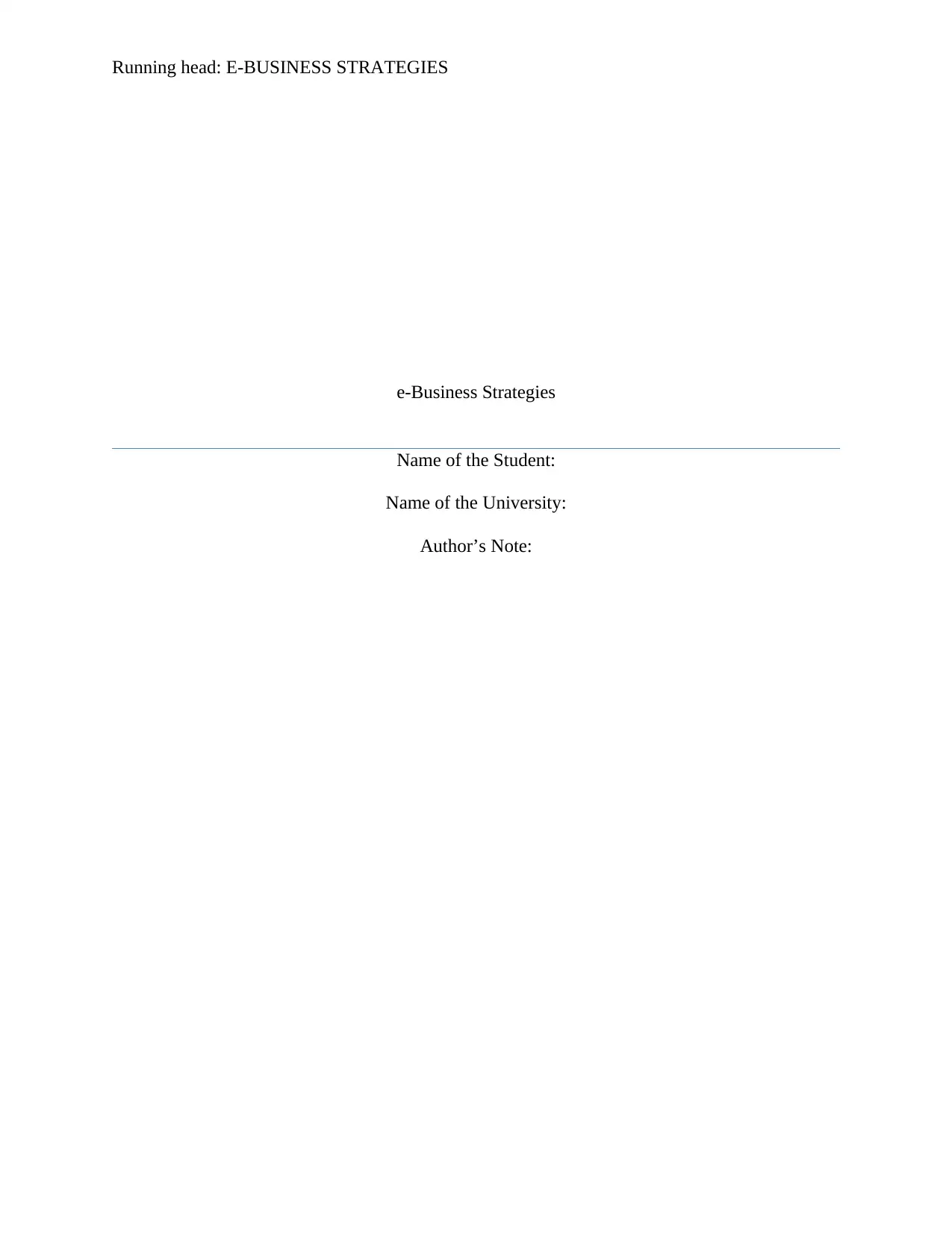
Running head: E-BUSINESS STRATEGIES
e-Business Strategies
Name of the Student:
Name of the University:
Author’s Note:
e-Business Strategies
Name of the Student:
Name of the University:
Author’s Note:
Paraphrase This Document
Need a fresh take? Get an instant paraphrase of this document with our AI Paraphraser
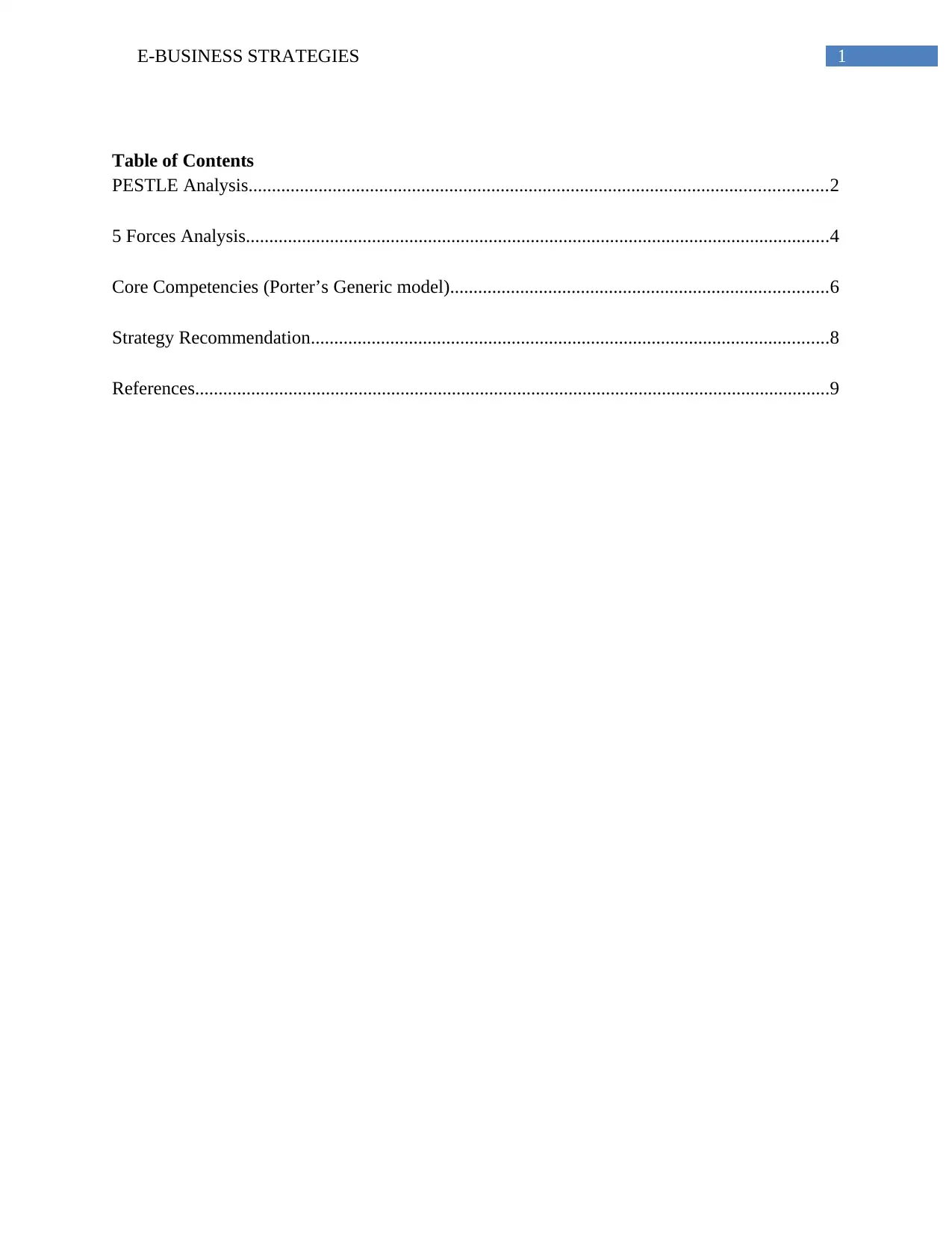
1E-BUSINESS STRATEGIES
Table of Contents
PESTLE Analysis............................................................................................................................2
5 Forces Analysis.............................................................................................................................4
Core Competencies (Porter’s Generic model).................................................................................6
Strategy Recommendation...............................................................................................................8
References........................................................................................................................................9
Table of Contents
PESTLE Analysis............................................................................................................................2
5 Forces Analysis.............................................................................................................................4
Core Competencies (Porter’s Generic model).................................................................................6
Strategy Recommendation...............................................................................................................8
References........................................................................................................................................9
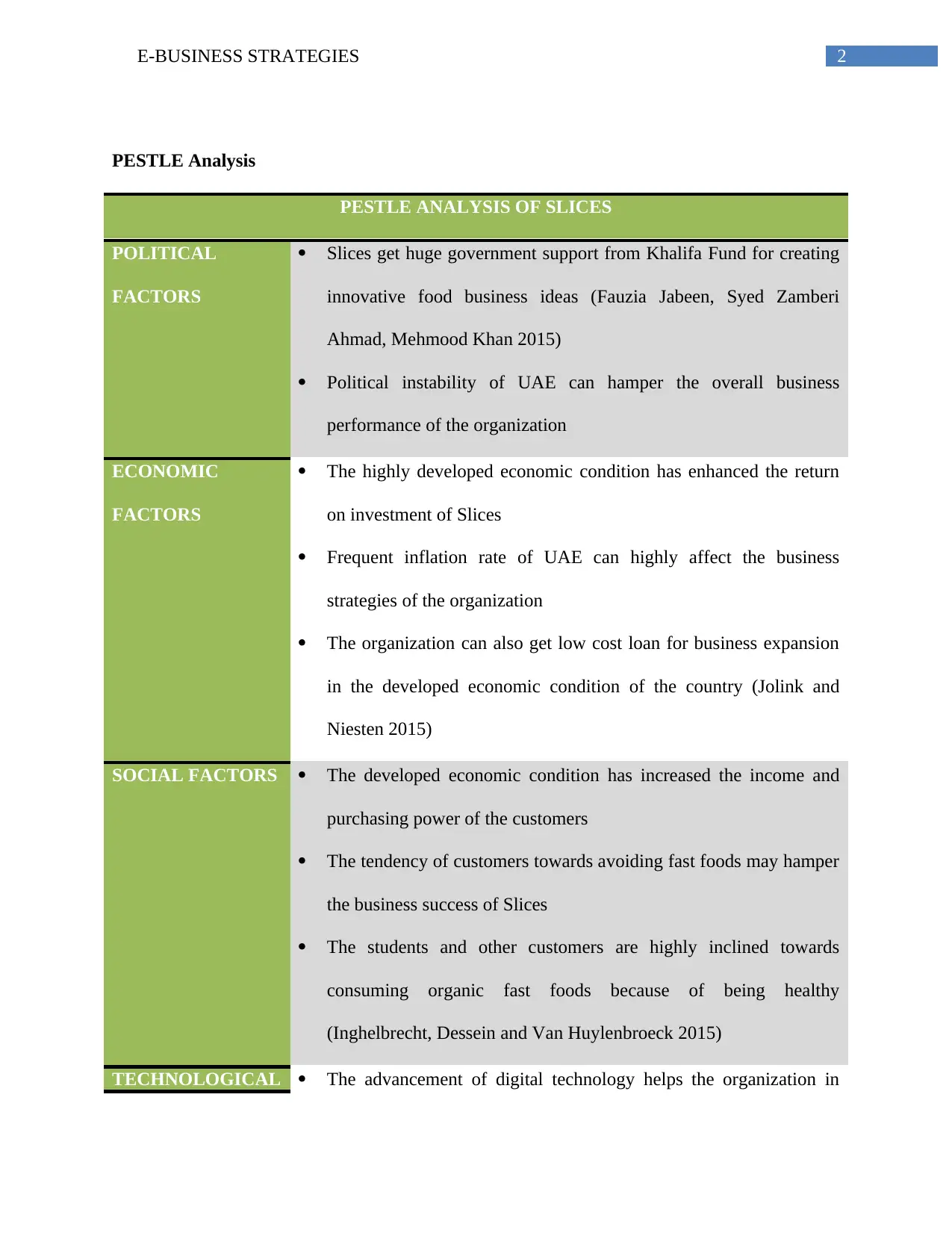
2E-BUSINESS STRATEGIES
PESTLE Analysis
PESTLE ANALYSIS OF SLICES
POLITICAL
FACTORS
Slices get huge government support from Khalifa Fund for creating
innovative food business ideas (Fauzia Jabeen, Syed Zamberi
Ahmad, Mehmood Khan 2015)
Political instability of UAE can hamper the overall business
performance of the organization
ECONOMIC
FACTORS
The highly developed economic condition has enhanced the return
on investment of Slices
Frequent inflation rate of UAE can highly affect the business
strategies of the organization
The organization can also get low cost loan for business expansion
in the developed economic condition of the country (Jolink and
Niesten 2015)
SOCIAL FACTORS The developed economic condition has increased the income and
purchasing power of the customers
The tendency of customers towards avoiding fast foods may hamper
the business success of Slices
The students and other customers are highly inclined towards
consuming organic fast foods because of being healthy
(Inghelbrecht, Dessein and Van Huylenbroeck 2015)
TECHNOLOGICAL The advancement of digital technology helps the organization in
PESTLE Analysis
PESTLE ANALYSIS OF SLICES
POLITICAL
FACTORS
Slices get huge government support from Khalifa Fund for creating
innovative food business ideas (Fauzia Jabeen, Syed Zamberi
Ahmad, Mehmood Khan 2015)
Political instability of UAE can hamper the overall business
performance of the organization
ECONOMIC
FACTORS
The highly developed economic condition has enhanced the return
on investment of Slices
Frequent inflation rate of UAE can highly affect the business
strategies of the organization
The organization can also get low cost loan for business expansion
in the developed economic condition of the country (Jolink and
Niesten 2015)
SOCIAL FACTORS The developed economic condition has increased the income and
purchasing power of the customers
The tendency of customers towards avoiding fast foods may hamper
the business success of Slices
The students and other customers are highly inclined towards
consuming organic fast foods because of being healthy
(Inghelbrecht, Dessein and Van Huylenbroeck 2015)
TECHNOLOGICAL The advancement of digital technology helps the organization in
⊘ This is a preview!⊘
Do you want full access?
Subscribe today to unlock all pages.

Trusted by 1+ million students worldwide

3E-BUSINESS STRATEGIES
FACTORS better promoting it organic foods
Technological advancement also helps Slices in cooking varieties of
organic foods
LEGAL FACTORS Slices work with the specialists of pediatric nutrition and
communication specialists for maintaining the food standard as per
the food safety act of UAE
The consumer safety act often affects the business process of the
organization (Anwar and Hasnu 2016)
ENVIRONMENTA
L FACTOR
Slices promotes the messages of healthy food habit for the children
It adheres with the environmental acts of the UAE government
Table 1: PESTLE Analysis of Slices
(Source: Saguy and Sirotinskaya 2014)
From the above PESTLE analysis, it can be said that the instable political condition of
UAE often hampers the business success of Slices. Frequent inflation rate of the country leads to
uncertain profit margin of the organization. Furthermore, the people of UAE are highly
conscious about their health and started to avoid fast food. Such consumer tendency can hamper
the fast food sales volume of the organization. The food safety act of the country can impose
certain restrictions on the business process of Slices.
FACTORS better promoting it organic foods
Technological advancement also helps Slices in cooking varieties of
organic foods
LEGAL FACTORS Slices work with the specialists of pediatric nutrition and
communication specialists for maintaining the food standard as per
the food safety act of UAE
The consumer safety act often affects the business process of the
organization (Anwar and Hasnu 2016)
ENVIRONMENTA
L FACTOR
Slices promotes the messages of healthy food habit for the children
It adheres with the environmental acts of the UAE government
Table 1: PESTLE Analysis of Slices
(Source: Saguy and Sirotinskaya 2014)
From the above PESTLE analysis, it can be said that the instable political condition of
UAE often hampers the business success of Slices. Frequent inflation rate of the country leads to
uncertain profit margin of the organization. Furthermore, the people of UAE are highly
conscious about their health and started to avoid fast food. Such consumer tendency can hamper
the fast food sales volume of the organization. The food safety act of the country can impose
certain restrictions on the business process of Slices.
Paraphrase This Document
Need a fresh take? Get an instant paraphrase of this document with our AI Paraphraser

4E-BUSINESS STRATEGIES
Figure 1: PESTLE of Slices
(Source: Saguy and Sirotinskaya 2014)
5 Forces Analysis
5 FORCES ANALYSIS SLICES
THREATS OF NEW
ENTRANTS
Investment cost in restaurant business is quite high, which can
create entry barrier for new entrants in food industry
Moderate supply chain cost can encourage the new entrants to
establish new business
Moderate threats of new entrants
THREATS OF
SUBSTITUTES
The substitutes of Slices are local fast food shops and traditional
fast food companies
Lack of organic foods provided by the substitutes can impose less
PESTLEPoliticalGovernmentSupportEconomicDevelopedEconomySocialInclinationforHealthyFoodTechnologicalDigitalAdvancementLegalFoodSfateyActEnvironmentalHealthyFoodHabit
Figure 1: PESTLE of Slices
(Source: Saguy and Sirotinskaya 2014)
5 Forces Analysis
5 FORCES ANALYSIS SLICES
THREATS OF NEW
ENTRANTS
Investment cost in restaurant business is quite high, which can
create entry barrier for new entrants in food industry
Moderate supply chain cost can encourage the new entrants to
establish new business
Moderate threats of new entrants
THREATS OF
SUBSTITUTES
The substitutes of Slices are local fast food shops and traditional
fast food companies
Lack of organic foods provided by the substitutes can impose less
PESTLEPoliticalGovernmentSupportEconomicDevelopedEconomySocialInclinationforHealthyFoodTechnologicalDigitalAdvancementLegalFoodSfateyActEnvironmentalHealthyFoodHabit
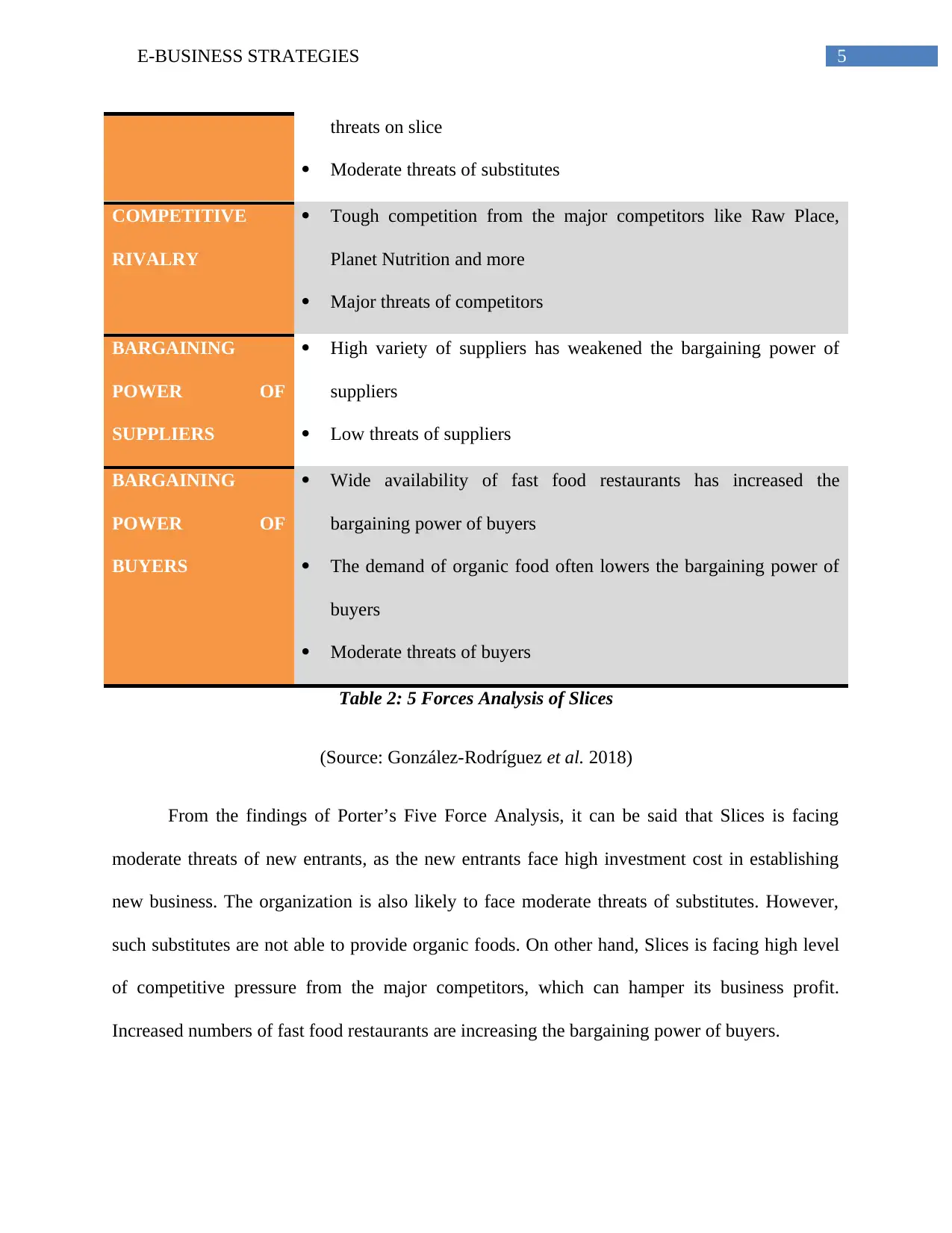
5E-BUSINESS STRATEGIES
threats on slice
Moderate threats of substitutes
COMPETITIVE
RIVALRY
Tough competition from the major competitors like Raw Place,
Planet Nutrition and more
Major threats of competitors
BARGAINING
POWER OF
SUPPLIERS
High variety of suppliers has weakened the bargaining power of
suppliers
Low threats of suppliers
BARGAINING
POWER OF
BUYERS
Wide availability of fast food restaurants has increased the
bargaining power of buyers
The demand of organic food often lowers the bargaining power of
buyers
Moderate threats of buyers
Table 2: 5 Forces Analysis of Slices
(Source: González-Rodríguez et al. 2018)
From the findings of Porter’s Five Force Analysis, it can be said that Slices is facing
moderate threats of new entrants, as the new entrants face high investment cost in establishing
new business. The organization is also likely to face moderate threats of substitutes. However,
such substitutes are not able to provide organic foods. On other hand, Slices is facing high level
of competitive pressure from the major competitors, which can hamper its business profit.
Increased numbers of fast food restaurants are increasing the bargaining power of buyers.
threats on slice
Moderate threats of substitutes
COMPETITIVE
RIVALRY
Tough competition from the major competitors like Raw Place,
Planet Nutrition and more
Major threats of competitors
BARGAINING
POWER OF
SUPPLIERS
High variety of suppliers has weakened the bargaining power of
suppliers
Low threats of suppliers
BARGAINING
POWER OF
BUYERS
Wide availability of fast food restaurants has increased the
bargaining power of buyers
The demand of organic food often lowers the bargaining power of
buyers
Moderate threats of buyers
Table 2: 5 Forces Analysis of Slices
(Source: González-Rodríguez et al. 2018)
From the findings of Porter’s Five Force Analysis, it can be said that Slices is facing
moderate threats of new entrants, as the new entrants face high investment cost in establishing
new business. The organization is also likely to face moderate threats of substitutes. However,
such substitutes are not able to provide organic foods. On other hand, Slices is facing high level
of competitive pressure from the major competitors, which can hamper its business profit.
Increased numbers of fast food restaurants are increasing the bargaining power of buyers.
⊘ This is a preview!⊘
Do you want full access?
Subscribe today to unlock all pages.

Trusted by 1+ million students worldwide
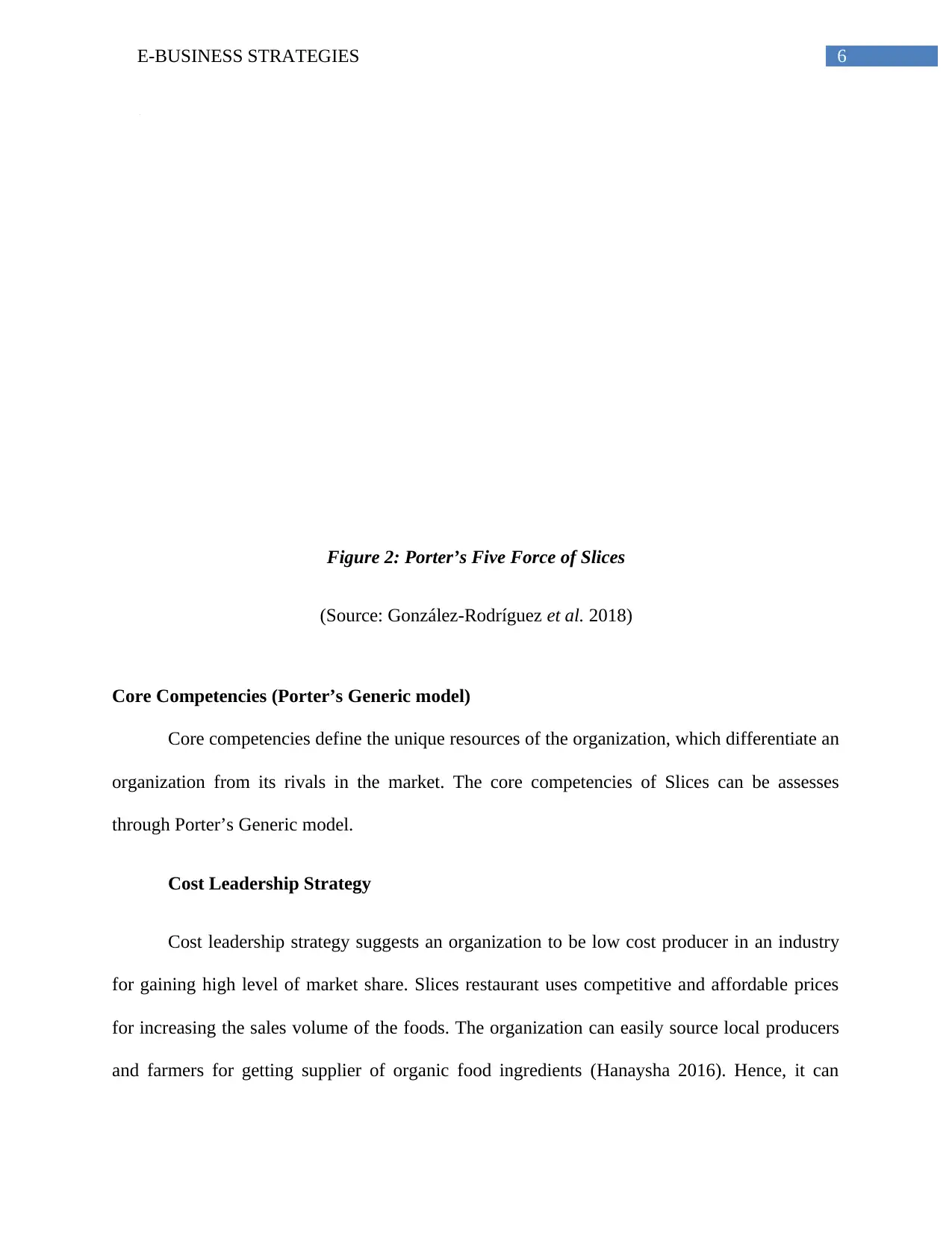
6E-BUSINESS STRATEGIES
Figure 2: Porter’s Five Force of Slices
(Source: González-Rodríguez et al. 2018)
Core Competencies (Porter’s Generic model)
Core competencies define the unique resources of the organization, which differentiate an
organization from its rivals in the market. The core competencies of Slices can be assesses
through Porter’s Generic model.
Cost Leadership Strategy
Cost leadership strategy suggests an organization to be low cost producer in an industry
for gaining high level of market share. Slices restaurant uses competitive and affordable prices
for increasing the sales volume of the foods. The organization can easily source local producers
and farmers for getting supplier of organic food ingredients (Hanaysha 2016). Hence, it can
CompetitiveRivalryHigh
Figure 2: Porter’s Five Force of Slices
(Source: González-Rodríguez et al. 2018)
Core Competencies (Porter’s Generic model)
Core competencies define the unique resources of the organization, which differentiate an
organization from its rivals in the market. The core competencies of Slices can be assesses
through Porter’s Generic model.
Cost Leadership Strategy
Cost leadership strategy suggests an organization to be low cost producer in an industry
for gaining high level of market share. Slices restaurant uses competitive and affordable prices
for increasing the sales volume of the foods. The organization can easily source local producers
and farmers for getting supplier of organic food ingredients (Hanaysha 2016). Hence, it can
CompetitiveRivalryHigh
Paraphrase This Document
Need a fresh take? Get an instant paraphrase of this document with our AI Paraphraser

7E-BUSINESS STRATEGIES
produce food products in very low cost and provide them at affordable prices to the customers.
Furthermore, the advanced technology has assisted the organization in manufacturing food
products at lowest cost. In this way, advanced technology has assisted the organization to offer
food product to the customers at lowest cost.
Differentiation Strategy
Differentiation strategy suggests the development of products and service, which
provides unique value to the customers. Slices restaurant highly follows differentiation strategy
for gaining competitive advantage over the rivals in the market. Moreover, the organic food
ingredients of Slices concerns about the healthy body of the customers (Davcik and Sharma
2015). Furthermore, the customers can also choose wide varieties of organic foods, which meet
their different kinds of food needs. The freshness of foods add extra added value to the
customers, which leads them to be loyal towards the organization. The highly trained and
motivated employees always offer high quality customer service towards enhancing the level of
customer satisfaction.
Focus Strategy
Focus strategy concentrate on narrow segment of customers and within that segment tries
to achieve either cost leadership or differentiation. In such strategy, Slices restaurant focuses on
students and executives of schools and universities for bettering serving their food needs (Ajagbe
et al. 2016). Moreover, the organization follows differentiating strategy for meeting the unique
healthy food needs of the students.
produce food products in very low cost and provide them at affordable prices to the customers.
Furthermore, the advanced technology has assisted the organization in manufacturing food
products at lowest cost. In this way, advanced technology has assisted the organization to offer
food product to the customers at lowest cost.
Differentiation Strategy
Differentiation strategy suggests the development of products and service, which
provides unique value to the customers. Slices restaurant highly follows differentiation strategy
for gaining competitive advantage over the rivals in the market. Moreover, the organic food
ingredients of Slices concerns about the healthy body of the customers (Davcik and Sharma
2015). Furthermore, the customers can also choose wide varieties of organic foods, which meet
their different kinds of food needs. The freshness of foods add extra added value to the
customers, which leads them to be loyal towards the organization. The highly trained and
motivated employees always offer high quality customer service towards enhancing the level of
customer satisfaction.
Focus Strategy
Focus strategy concentrate on narrow segment of customers and within that segment tries
to achieve either cost leadership or differentiation. In such strategy, Slices restaurant focuses on
students and executives of schools and universities for bettering serving their food needs (Ajagbe
et al. 2016). Moreover, the organization follows differentiating strategy for meeting the unique
healthy food needs of the students.
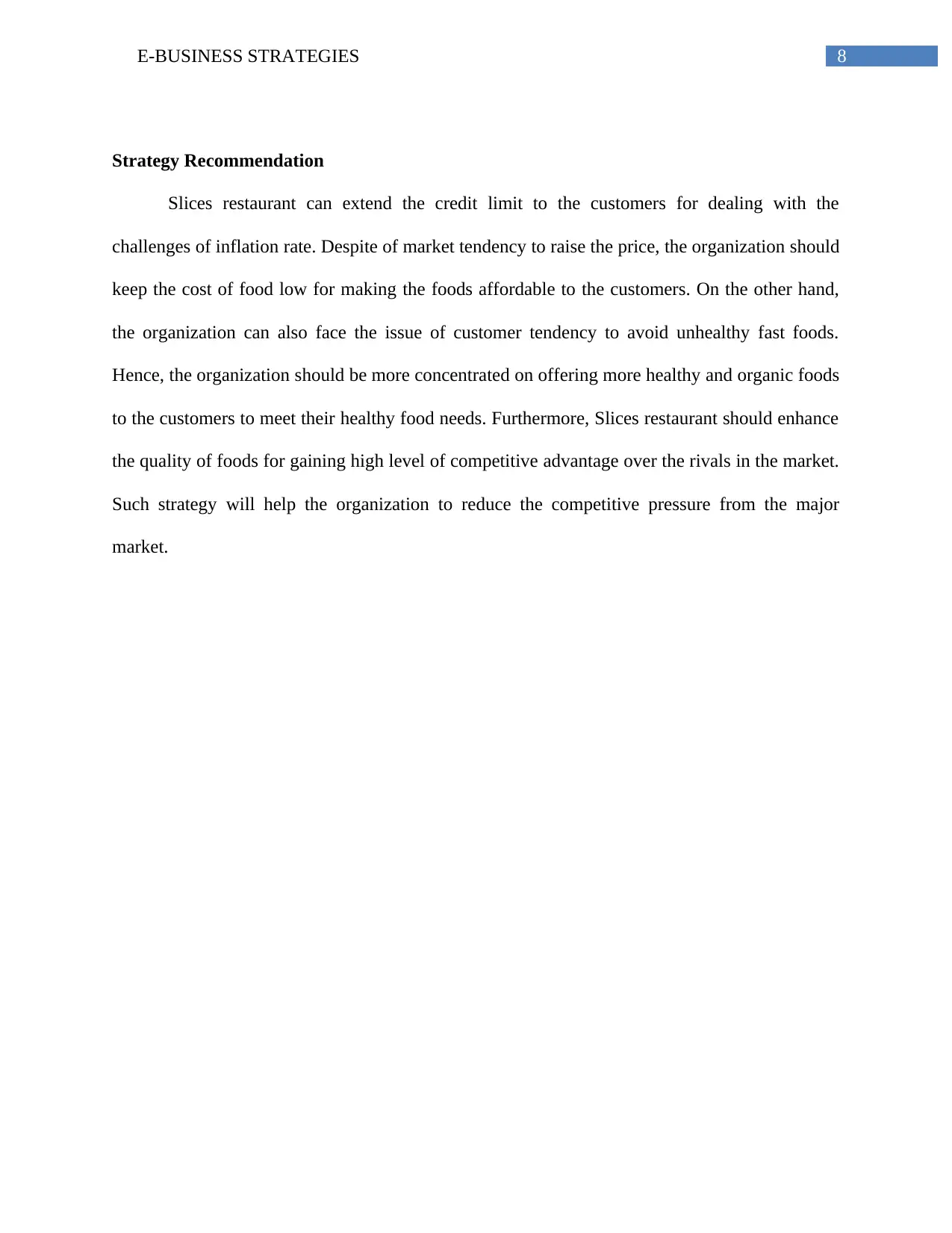
8E-BUSINESS STRATEGIES
Strategy Recommendation
Slices restaurant can extend the credit limit to the customers for dealing with the
challenges of inflation rate. Despite of market tendency to raise the price, the organization should
keep the cost of food low for making the foods affordable to the customers. On the other hand,
the organization can also face the issue of customer tendency to avoid unhealthy fast foods.
Hence, the organization should be more concentrated on offering more healthy and organic foods
to the customers to meet their healthy food needs. Furthermore, Slices restaurant should enhance
the quality of foods for gaining high level of competitive advantage over the rivals in the market.
Such strategy will help the organization to reduce the competitive pressure from the major
market.
Strategy Recommendation
Slices restaurant can extend the credit limit to the customers for dealing with the
challenges of inflation rate. Despite of market tendency to raise the price, the organization should
keep the cost of food low for making the foods affordable to the customers. On the other hand,
the organization can also face the issue of customer tendency to avoid unhealthy fast foods.
Hence, the organization should be more concentrated on offering more healthy and organic foods
to the customers to meet their healthy food needs. Furthermore, Slices restaurant should enhance
the quality of foods for gaining high level of competitive advantage over the rivals in the market.
Such strategy will help the organization to reduce the competitive pressure from the major
market.
⊘ This is a preview!⊘
Do you want full access?
Subscribe today to unlock all pages.

Trusted by 1+ million students worldwide
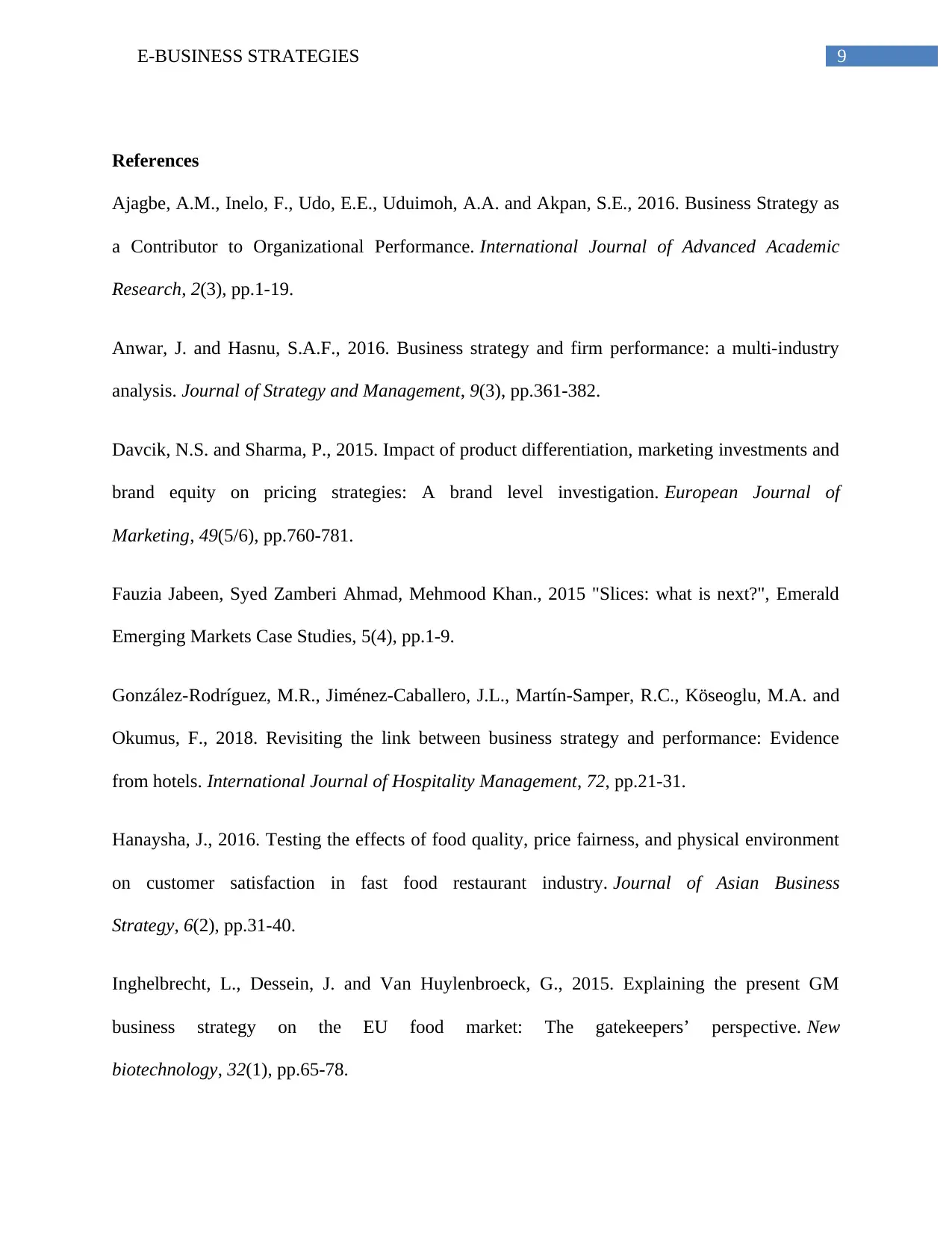
9E-BUSINESS STRATEGIES
References
Ajagbe, A.M., Inelo, F., Udo, E.E., Uduimoh, A.A. and Akpan, S.E., 2016. Business Strategy as
a Contributor to Organizational Performance. International Journal of Advanced Academic
Research, 2(3), pp.1-19.
Anwar, J. and Hasnu, S.A.F., 2016. Business strategy and firm performance: a multi-industry
analysis. Journal of Strategy and Management, 9(3), pp.361-382.
Davcik, N.S. and Sharma, P., 2015. Impact of product differentiation, marketing investments and
brand equity on pricing strategies: A brand level investigation. European Journal of
Marketing, 49(5/6), pp.760-781.
Fauzia Jabeen, Syed Zamberi Ahmad, Mehmood Khan., 2015 "Slices: what is next?", Emerald
Emerging Markets Case Studies, 5(4), pp.1-9.
González-Rodríguez, M.R., Jiménez-Caballero, J.L., Martín-Samper, R.C., Köseoglu, M.A. and
Okumus, F., 2018. Revisiting the link between business strategy and performance: Evidence
from hotels. International Journal of Hospitality Management, 72, pp.21-31.
Hanaysha, J., 2016. Testing the effects of food quality, price fairness, and physical environment
on customer satisfaction in fast food restaurant industry. Journal of Asian Business
Strategy, 6(2), pp.31-40.
Inghelbrecht, L., Dessein, J. and Van Huylenbroeck, G., 2015. Explaining the present GM
business strategy on the EU food market: The gatekeepers’ perspective. New
biotechnology, 32(1), pp.65-78.
References
Ajagbe, A.M., Inelo, F., Udo, E.E., Uduimoh, A.A. and Akpan, S.E., 2016. Business Strategy as
a Contributor to Organizational Performance. International Journal of Advanced Academic
Research, 2(3), pp.1-19.
Anwar, J. and Hasnu, S.A.F., 2016. Business strategy and firm performance: a multi-industry
analysis. Journal of Strategy and Management, 9(3), pp.361-382.
Davcik, N.S. and Sharma, P., 2015. Impact of product differentiation, marketing investments and
brand equity on pricing strategies: A brand level investigation. European Journal of
Marketing, 49(5/6), pp.760-781.
Fauzia Jabeen, Syed Zamberi Ahmad, Mehmood Khan., 2015 "Slices: what is next?", Emerald
Emerging Markets Case Studies, 5(4), pp.1-9.
González-Rodríguez, M.R., Jiménez-Caballero, J.L., Martín-Samper, R.C., Köseoglu, M.A. and
Okumus, F., 2018. Revisiting the link between business strategy and performance: Evidence
from hotels. International Journal of Hospitality Management, 72, pp.21-31.
Hanaysha, J., 2016. Testing the effects of food quality, price fairness, and physical environment
on customer satisfaction in fast food restaurant industry. Journal of Asian Business
Strategy, 6(2), pp.31-40.
Inghelbrecht, L., Dessein, J. and Van Huylenbroeck, G., 2015. Explaining the present GM
business strategy on the EU food market: The gatekeepers’ perspective. New
biotechnology, 32(1), pp.65-78.
Paraphrase This Document
Need a fresh take? Get an instant paraphrase of this document with our AI Paraphraser

10E-BUSINESS STRATEGIES
Jolink, A. and Niesten, E., 2015. Sustainable development and business models of entrepreneurs
in the organic food industry. Business Strategy and the Environment, 24(6), pp.386-401.
Saguy, I.S. and Sirotinskaya, V., 2014. Challenges in exploiting open innovation's full potential
in the food industry with a focus on small and medium enterprises (SMEs). Trends in Food
Science & Technology, 38(2), pp.136-148.
Jolink, A. and Niesten, E., 2015. Sustainable development and business models of entrepreneurs
in the organic food industry. Business Strategy and the Environment, 24(6), pp.386-401.
Saguy, I.S. and Sirotinskaya, V., 2014. Challenges in exploiting open innovation's full potential
in the food industry with a focus on small and medium enterprises (SMEs). Trends in Food
Science & Technology, 38(2), pp.136-148.
1 out of 11
Related Documents
Your All-in-One AI-Powered Toolkit for Academic Success.
+13062052269
info@desklib.com
Available 24*7 on WhatsApp / Email
![[object Object]](/_next/static/media/star-bottom.7253800d.svg)
Unlock your academic potential
Copyright © 2020–2025 A2Z Services. All Rights Reserved. Developed and managed by ZUCOL.





